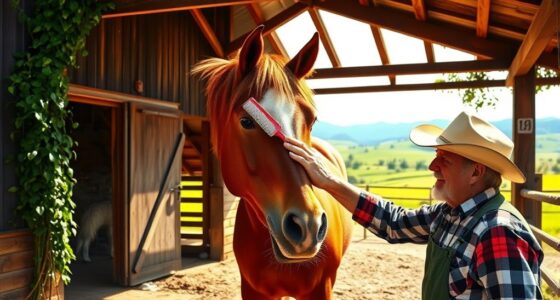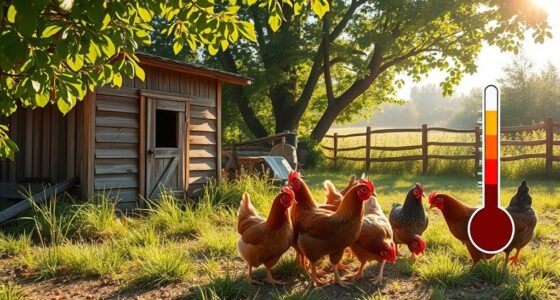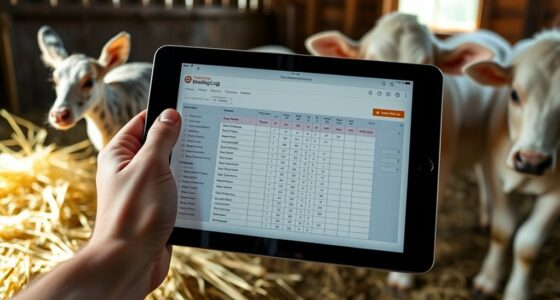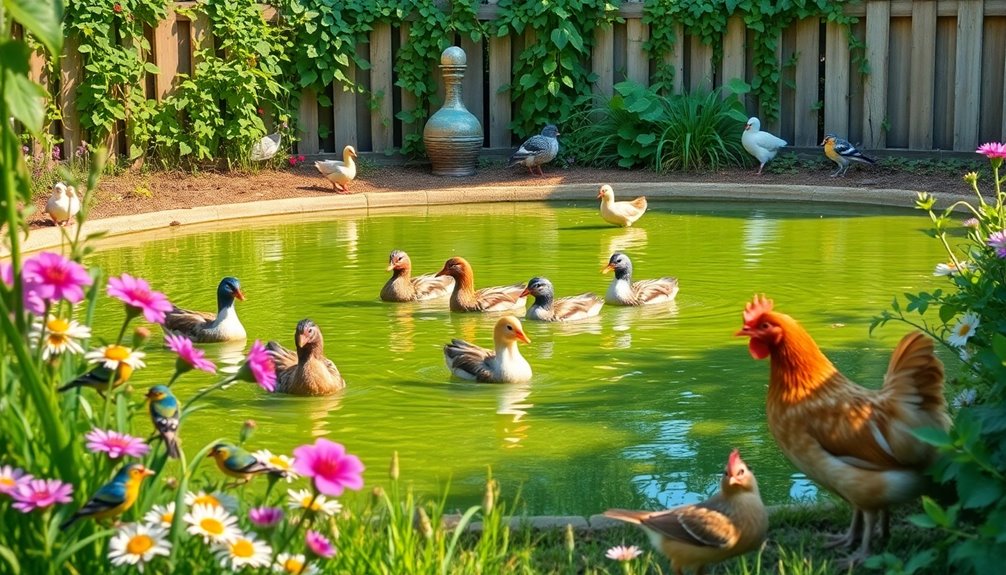As daylight shortens, you can manage breeding cycles by adjusting artificial lighting to mimic longer days, gradually increasing light exposure by 15-30 minutes daily. Maintain consistent schedules and use timers to replicate natural dawn and dusk cues, helping stimulate reproductive hormones. Monitor your animals’ behaviors and signs of fertility to fine-tune your setup. Implementing these strategies correctly can help sustain breeding success through darker months—keep exploring to discover more effective tips.
Key Takeaways
- Monitor natural light changes and adjust indoor lighting gradually to mimic seasonal photoperiods.
- Use timers and full-spectrum bulbs to maintain consistent, species-specific light exposure durations.
- Gradually decrease light exposure by 15-30 minutes daily to simulate shortening days.
- Observe animal behavior and reproductive signs to fine-tune lighting adjustments.
- Maintain a stable environment with controlled temperature and reduced stress to support reproductive cycles.
Understanding the Impact of Light on Reproductive Cycles

Light plays a crucial role in regulating reproductive cycles across many species. When the days grow longer or shorter, it sends signals to your animals’ biological systems, influencing hormone production. Increased daylight typically triggers the release of hormones that promote fertility, while decreasing light can suppress these signals, leading to reproductive pauses. Understanding this connection helps you anticipate natural breeding periods and manage them effectively. For example, some animals rely on daylight cues to time their mating seasons precisely. By recognizing how light impacts hormone levels and reproductive readiness, you can better align your management practices with natural cycles. Additionally, AI Security technologies can assist in monitoring environmental factors like light exposure to optimize breeding conditions. This knowledge enables you to optimize breeding times, improve success rates, and ensure healthier, more synchronized offspring production.
Monitoring Natural Light Levels and Seasonal Changes

You need to keep an eye on the changing daylight hours and seasonal shifts, as these influence breeding readiness. By tracking the length of days and seasonal light patterns, you can better understand how natural conditions affect your animals. Adjust your lighting setup accordingly to mimic natural light cycles and support ideal reproductive timing. Incorporating light management techniques can further optimize breeding cycles in response to seasonal changes.
Tracking Daylight Duration
Understanding the natural fluctuations in daylight duration is essential for managing breeding cycles effectively. To do this, you need to track the hours of daylight each day consistently. Use a reliable calendar or a light-tracking app to record sunrise and sunset times, noting how many hours of light your animals experience. Pay attention to gradual changes over weeks, not just daily fluctuations, so you can identify trends. Installing a light meter can also help you measure actual light intensity in your environment. By monitoring these patterns, you’ll better understand how daylight influences your animals’ reproductive readiness. Accurate tracking allows you to plan interventions or adjustments, ensuring your breeding program aligns with natural light cues and supports peak reproductive health. Incorporating natural light patterns into your management strategies can significantly improve breeding success.
Seasonal Light Variations
Monitoring natural light levels throughout the year reveals how seasonal changes influence the environment your animals experience. These fluctuations impact their behavior, activity patterns, and reproductive cycles. By observing these variations, you can better understand how daylight shifts affect your animals’ natural rhythms. Incorporating color temperature adjustments can further refine your understanding of how lighting conditions influence animal behavior and health.
- Track the length of daylight hours daily and note seasonal peaks and lows
- Record weather patterns that coincide with seasonal light changes
- Observe behavioral shifts, such as activity levels or breeding readiness
- Compare light data with natural breeding periods to identify correlations
Staying aware of these seasonal light variations helps you anticipate changes in animal behavior and plan accordingly. Recognizing these natural patterns supports effective management of breeding cycles aligned with environmental cues.
Adjusting Lighting Conditions
Adjusting lighting conditions based on natural light levels and seasonal changes is essential for aligning your animals’ reproductive cycles with their environment. You should regularly monitor outdoor light levels and note seasonal shifts to adjust your indoor lighting accordingly. Use timers or automated systems to simulate natural daylight patterns, gradually increasing or decreasing light exposure as seasons change. This helps maintain consistent breeding cues, preventing disruptions caused by abrupt lighting shifts. Pay attention to sunrise and sunset times, adjusting your lighting schedule to match these changes. By fine-tuning your lighting setup, you create a stable environment that encourages healthy reproductive cycles and minimizes stress for your animals, ensuring they’re primed for breeding during ideal times of the year. Incorporating light pollution awareness can further refine these adjustments, promoting optimal conditions for your animals’ reproductive health.
Using Artificial Lighting to Simulate Longer Daylight Hours

Artificial lighting can be a powerful tool to extend the perceived daylight hours for breeding animals. By providing supplemental light, you can trick animals into thinking days are longer, encouraging reproductive activity even when natural daylight is limited. It’s important to choose the right type of light, such as full-spectrum bulbs that mimic natural sunlight. You’ll want to set timers to ensure consistent daily exposure, typically around 14-16 hours of light. Adjust the light intensity and duration based on the species’ needs, avoiding abrupt changes that could stress the animals. Regularly monitor their behavior and reproductive signals to gauge effectiveness. Proper artificial lighting helps maintain breeding cycles, ensuring animals stay productive despite shorter days. Incorporating advanced fraud detection techniques can enhance the overall management of breeding data and health records, ensuring accurate tracking and security.
Establishing Consistent Lighting Schedules for Breeding Success

To improve breeding success, you need to establish a consistent lighting schedule that mimics natural photoperiods. Keep your lighting times steady and adjust gradually to avoid stressing your animals. This approach helps regulate their cycles and encourages successful breeding. Incorporating light cycle management can further optimize reproductive outcomes.
Mimic Natural Photoperiods
Since natural light cycles influence breeding behavior, mimicking these patterns through consistent lighting schedules can substantially improve your success. You want to replicate the gradual changes in daylight to signal breeding seasons accurately. Adjust your lighting to match the natural photoperiods, gradually increasing or decreasing light exposure to simulate dawn and dusk. Maintaining a stable cycle helps your animals recognize breeding cues and reduces stress. Consistency is key—avoid abrupt changes that could disrupt their rhythm. Use timers to ensure lights turn on and off at precise times, mimicking natural variability. This approach encourages natural hormonal responses, making your breeding program more reliable. Ensure your lighting setup is compatible with timers and can be adjusted gradually to reflect seasonal changes.
Use Consistent Lighting Times
Establishing consistent lighting times is vital for creating a reliable environment that signals breeding readiness. You should set a fixed schedule for turning lights on and off each day, ensuring your animals experience a predictable cycle. Avoid sudden changes or irregularities, as these can confuse their internal clocks and disrupt breeding patterns. Use a timer to maintain accuracy and consistency, especially during the transition period. Consistent lighting helps reinforce the natural cues that your animals rely on for reproductive behavior. By sticking to the same schedule daily, you reduce stress and increase the likelihood of successful breeding. Additionally, understanding the horsepower of electric dirt bikes can help you appreciate how power and performance are linked to environmental factors, emphasizing the importance of a stable setting for optimal activity. Remember, animals respond best when their environment is stable and predictable, making consistent lighting times essential for optimal breeding outcomes.
Adjust Gradually for Breeding
While maintaining consistent lighting times is important, abrupt changes can still disrupt your animals’ breeding signals. To avoid this, you should adjust lighting gradually over several days. Slowly increase or decrease the light duration by 15-30 minutes daily to help your animals adapt smoothly. Monitoring their responses is essential; if you notice signs of stress or confusion, slow down the adjustment process. Keep the schedule steady once the desired cycle is reached, reinforcing the breeding rhythm. Consistency and patience are key to ensuring successful breeding.
- Use a timer to control gradual light adjustments
- Record daily changes to track progress
- Observe animals for signs of stress or disorientation
- Maintain a stable environment alongside lighting changes
Adjusting Feeding and Environmental Conditions During Shorter Days
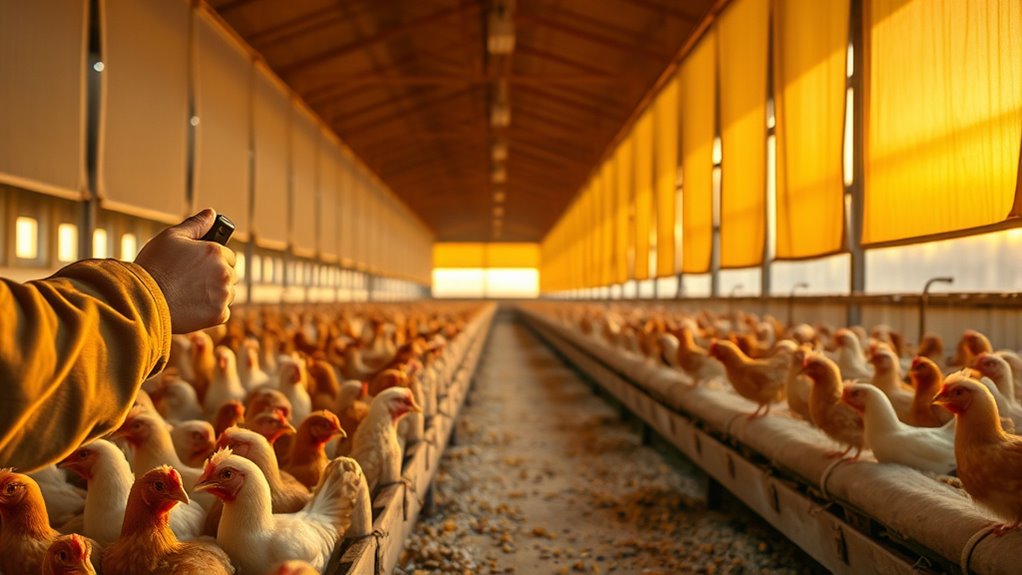
As days grow shorter, it’s vital to adjust your feeding and environmental strategies to support ideal breeding cycles. Increase energy-rich foods to meet animals’ higher nutritional needs during this time. Offer higher protein and energy levels to promote reproductive health and maintain body condition. Meanwhile, modify your environment by controlling light exposure; ensure animals receive consistent, adequate lighting to simulate longer days and prevent disruptions in their biological rhythms. Keep temperatures stable and comfortable, avoiding fluctuations that could stress animals. Maintaining a clean, well-ventilated space is also essential, as stress from poor conditions can impair reproductive functions. Additionally, monitoring light management closely helps prevent disruptions to animals’ circadian rhythms. By fine-tuning these feeding and environmental factors, you help your animals stay healthy and promote optimal breeding readiness despite the shorter daylight hours.
Recognizing Signs of Reproductive Readiness in Animals

Understanding the signs of reproductive readiness in your animals allows you to determine the ideal time for breeding. By observing specific behaviors and physical cues, you can identify when your animals are most fertile. Look for increased activity, such as restlessness or vocalizations, which indicate hormonal changes. Physical signs include swelling or reddening of the genital area, indicating heat or estrus. For females, check for a change in vaginal discharge that becomes more prominent during the cycle. Males may show heightened interest in females, along with increased scent marking. Monitoring these signs consistently helps you pinpoint the most suitable breeding window, improving success rates and animal health. Recognizing these cues early ensures you don’t miss the prime opportunity for successful mating.
Timing Breeding Activities for Optimal Outcomes

Timing your breeding activities precisely is essential to maximize the chances of successful mating and healthy offspring. As daylight shortens, you need to monitor environmental cues and animal behavior closely. Keep track of changes in activity levels, vocalizations, and physical signs indicating reproductive readiness. Plan your breeding sessions during the animals’ peak fertility window, which often coincides with specific times of day or night, depending on the species. Using tools like light timers or natural light cycles helps you create consistent conditions. Avoid rushing or delaying breeding, as mistimed efforts can reduce success rates. Consistent observation and planning ensure you align your activities with your animals’ natural cycles, increasing the likelihood of conception and healthy development.
Troubleshooting Common Challenges in Short-Day Breeding Management

Short-day breeders often face unique challenges that can disrupt their reproductive cycles, making troubleshooting essential for successful management. You might notice irregular estrous cycles, delayed or missed breeding windows, or inconsistent ovulation. Environmental factors, like inadequate light control or stress, often contribute to these issues. To troubleshoot effectively:
- Check your lighting setup to ensure proper duration and intensity
- Minimize stressors such as noise, movement, or poor nutrition
- Monitor hormone levels or reproductive signs to identify delays
- Adjust light schedules gradually to prevent sudden disruptions
Long-term Strategies for Year-Round Breeding Efficiency

Implementing long-term strategies can substantially enhance your ability to maintain consistent breeding cycles throughout the year. One effective approach is to control your environment by using artificial lighting to simulate ideal daylight hours, ensuring your animals receive a stable light schedule regardless of season. Regularly monitor and adjust temperature and humidity levels to create perfect conditions, reducing stress and promoting fertility. Consider rotating breeding stock or implementing a planned breeding schedule that aligns with natural cycles while maintaining flexibility for adjustments. Keep detailed records of breeding dates, responses, and environmental conditions to identify patterns and optimize future cycles. Developing these strategies helps you sustain high breeding efficiency year-round, minimizing seasonal dips and ensuring a steady flow of offspring.
Frequently Asked Questions
How Can I Identify Early Signs of Reproductive Readiness?
You can spot early signs of reproductive readiness by observing behavioral changes, like increased vocalization or restlessness. Look for physical cues such as swelling of the vulva, mucus discharge, or increased grooming around the genital area. You might also notice a heightened interest in males or specific postures indicating receptivity. Regular monitoring and noting these signs help you determine the most suitable time for breeding, ensuring better success rates.
What Are the Best Ways to Prevent Lighting Disruptions?
To prevent lighting disruptions, you should consistently use a reliable lighting schedule and avoid turning lights on or off unexpectedly. Invest in automated timers and make sure they function correctly, maintaining a steady light cycle. Keep the environment free from drafts or disturbances that can cause fluctuations. Regularly check the lighting system for issues, and communicate with staff to ensure everyone adheres to the schedule, minimizing disruptions.
How Does Weather Affect Breeding Cycles During Short Days?
Weather impacts your breeding cycles during short days by influencing environmental cues. Cold temperatures and overcast skies can delay or disrupt hormonal signals, making animals less receptive to breeding. Sudden weather changes may cause irregular cycles. To counter this, you should monitor weather patterns closely, provide controlled lighting to simulate ideal conditions, and guarantee proper sheltering to minimize weather-related stress, helping maintain consistent breeding schedules despite changing weather.
Are There Specific Breeds More Sensitive to Light Changes?
Yes, some breeds are more sensitive to light changes. For instance, thoroughbreds and certain dairy breeds respond quickly to decreasing daylight, which can affect their breeding cycles. You’ll notice these breeds might have irregular cycles or delayed fertility as daylight shortens. To manage this, you should monitor their responses closely and consider supplemental lighting or adjusted schedules to maintain consistent breeding readiness.
How Can I Balance Artificial Lighting With Natural Conditions?
You should use a combination of natural and artificial light to mimic the natural daylight cycle. Start by providing consistent artificial lighting that extends daylight hours to match the season’s length. Guarantee your lighting setup is adjustable, so you can gradually decrease or increase light exposure as days shorten or lengthen. Regularly monitor your animals’ behavior and health to fine-tune the balance, promoting ideal breeding and well-being.
Conclusion
By mastering light management, you hold the key to revealing breeding success even as days grow shorter. With consistent schedules and smart adjustments, you can keep your animals in peak reproductive condition year-round. Don’t let the changing seasons catch you off guard—think of it as turning the darkest night into the brightest dawn. Stay vigilant, adapt proactively, and watch your breeding program thrive like never before. The power to excel is in your hands!


